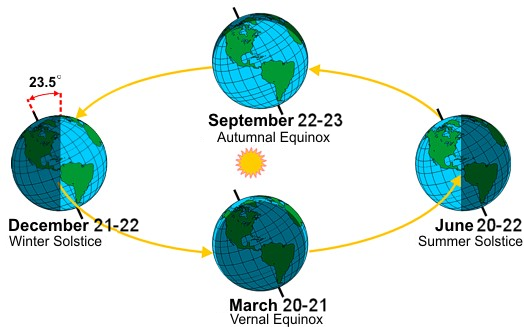Geography
Autumnal Equinox in Northern Hemisphere
- 23 Sep 2020
- 4 min read
Why in News
On 22nd September 2020, the day and night was almost equal in most locations marking the start of autumn in the Northern Hemisphere which lasts until the winter solstice (December 21 or 22).
- Similarly, the Vernal equinox falls around March 21, marking the start of spring in the Northern Hemisphere.
- In the Southern Hemisphere the seasons are reversed (Christmas is celebrated in Australia and New Zealand in the summer season).
Key Points
- About:
- The word equinox is derived from two Latin words - aequus (equal) and nox (night).
- There are only two times of the year when the Earth's axis is tilted neither toward nor away from the sun, resulting in a nearly equal amount of daylight and darkness at all latitudes. These events are referred to as Equinoxes.
- The equinoxes happen in March (about March 21) and September (about September 23). These are the days when the Sun is exactly above the Equator, which makes day and night of equal length.
- It can be noted that the most places on Earth receive more than 12 hours of daylight on equinoxes. This is because of the atmospheric refraction of sunlight and how the length of the day is defined.
- The equinoxes are prime time for Northern Lights – geomagnetic activities are twice more likely to take place in the spring and fall time, than in the summer or winter.
- Varying Dates: While the September equinox usually occurs on September 22 or 23, it can very rarely fall on September 21 or September 24.
- This is because of the difference between how the Gregorian calendar defines a year (365 days) and the time it actually takes for Earth to complete its orbit around the Sun (about 365 and 1/4 days).
- This means that each equinox occurs about 6 hours later than the previous year's Equinox. This eventually moves the date by a day.
- Signals Changing of Seasons: The equinoxes along with solstices signals the changing of the seasons.
- The seasons on Earth change because the planet is slightly tilted on its axis as it travels around the Sun. Earth’s rotational axis makes an angle of 23.5° with the normal and angle of 66.5° with the orbital plane.
- If Earth were not tilted, the Sun would always appear to be directly above the Equator, the amount of light a given location receives would be fixed, and there would be no seasons. There also would be no need to mark equinoxes or solstices.
- Solstices: The two solstices happen in June (20 or 21) and December (21 or 22). These are the days when the Sun’s path in the sky is the farthest north or south from the Equator.
- In the Northern Hemisphere, the June solstice marks the start of summer, this is when the North Pole is tilted closest to the Sun, and the Sun’s rays are directly overhead at the Tropic of Cancer.
- In the Northern Hemisphere, the December solstice marks the start of winter, this is when the South Pole is tilted closest to the Sun, and the Sun’s rays are directly overhead at the Tropic of Capricorn.







